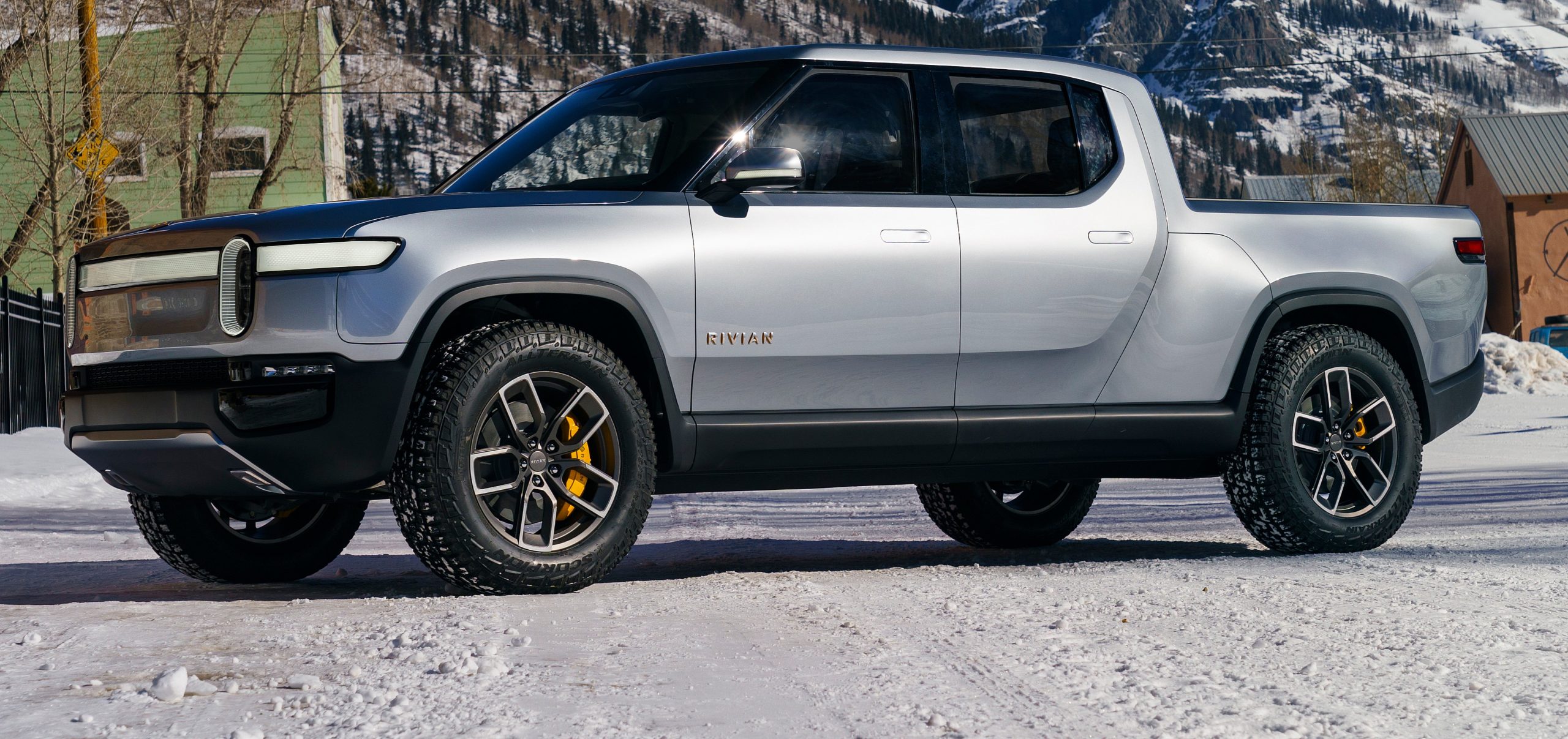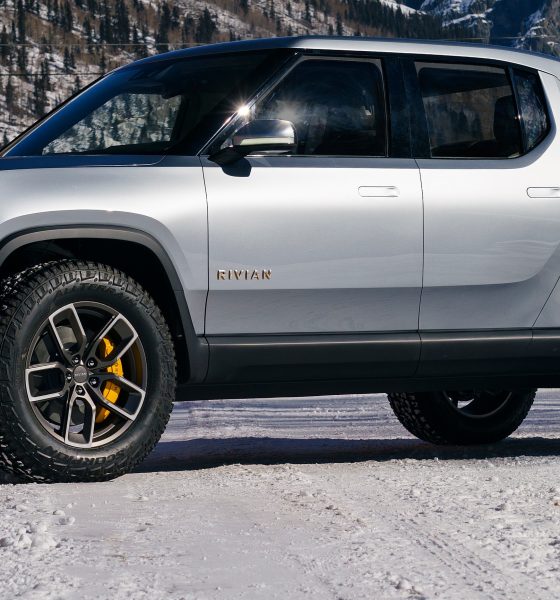

News
Rivian trademark filings hint at possible crossover, sedan in the works
Rivian has released many development and marketing details surrounding its coming all-electric R1T pickup truck and R1S SUV over the last few months, but recently published US trademark applications hint that the Michigan-based startup has a crossover, sedan, and second generation vehicles already in the works.
Several Rivian-owned US trademark applications were recently published for opposition at the end of March, meaning the applications are pending a waiting period for objections to be filed before they become officially registered. The 1S and 1T names already associated with Rivian were included in the batch, but several others not currently tied to a revealed product were as well: 1C, 1A, 2C, 2A, 2S, 2T, and 2R.
Rivian’s current naming scheme using single letters to denote its vehicle types – ‘T’ for truck, ‘S’ for SUV – indicate that its application for the trademark ‘1C’ could correspond to a “crossover,” and the ‘2’ included in some of the new marks could hint at the next generation of its flagship vehicles. However, the remaining ‘A’ and ‘R’ designations are not as easy to guess.

Initial entry into the luxury vehicle market for car manufacturers is a tried and true strategy for new companies and new vehicle lines, and the popularity of larger utilitarian cars in the US altogether explain Rivian’s first focus on pricey SUVs and trucks. But it’s likely that the all-electric startup will expand into the sedan market shortly after either manufacturing or deliveries begin, which is probably where the ‘A’ and ‘R’ designations in Rivian’s trademarks are intended to be used.
Audi might have the biggest hint for interpreting Rivian’s intentions – its ‘A’ and ‘R’ monikers are attached to its sedans and sportbacks, respectively. The company’s ascending numerical designations (A3, A4, etc.) correlate to performance enhancements (higher the better), but Rivian’s intentions could go another direction.
One of Rivian’s primary competitors, the Ford F-150, uses catchy names like ‘Raptor’, ‘King Ranch’, and ‘Platinum’ to designate its variations rather than letters. The names aren’t simply tied to increasing performance enhancements but rather their intended use. Rivian could adopt a correlation like Ford’s and use its numbering system to indicate whether the vehicle had a city or outdoor adventure focus, for example.

Rivian’s intentions for its upcoming all-electric R1T pickup truck and R1S SUV have been a fun source of speculation within its new and growing enthusiast community. Several graphic renderings imagining its modular capabilities were published by the team running RivianForums, inspired by the company’s patent application for such a system. Other visions of aftermarket off-road additions have also been published for community enjoyment.
The excitement for its vehicles has been duly noted and encouraged by Rivian as well. The company will appear at this month’s New York International Auto Show and has scheduled a special showing for reservation holders a few days prior to the event at a local car club. Attendees will enjoy cocktails, hors d’oeuvres, and a greeting by the company’s CEO and founder, RJ Scaringe, all while being treated to an in-person look at Rivian’s current vehicles, both of which boast up to 400 miles per charge, high-powered quad motors, and a 0-60 mph acceleration time of 3 seconds.

Elon Musk
Elon Musk’s X will start using a Tesla-like software update strategy
The initiative seems designed to accelerate updates to the social media platform, while maintaining maximum transparency.

Elon Musk’s social media platform X will adopt a Tesla-esque approach to software updates for its algorithm.
The initiative seems designed to accelerate updates to the social media platform, while maintaining maximum transparency.
X’s updates to its updates
As per Musk in a post on X, the social media company will be making a new algorithm to determine what organic and advertising posts are recommended to users. These updates would then be repeated every four weeks.
“We will make the new 𝕏 algorithm, including all code used to determine what organic and advertising posts are recommended to users, open source in 7 days. This will be repeated every 4 weeks, with comprehensive developer notes, to help you understand what changed,” Musk wrote in his post.
The initiative somewhat mirrors Tesla’s over-the-air update model, where vehicle software is regularly refined and pushed to users with detailed release notes. This should allow users to better understand the details of X’s every update and foster a healthy feedback loop for the social media platform.
xAI and X
X, formerly Twitter, has been acquired by Elon Musk’s artificial intelligence startup, xAI last year. Since then, xAI has seen a rapid rise in valuation. Following the company’s the company’s upsized $20 billion Series E funding round, estimates now suggest that xAI is worth tens about $230 to $235 billion. That’s several times larger than Tesla when Elon Musk received his controversial 2018 CEO Performance Award.
As per xAI, the Series E funding round attracted a diverse group of investors, including Valor Equity Partners, Stepstone Group, Fidelity Management & Research Company, Qatar Investment Authority, MGX, and Baron Capital Group, among others. Strategic partners NVIDIA and Cisco Investments also continued support for building the world’s largest GPU clusters.
News
Tesla FSD Supervised wins MotorTrend’s Best Driver Assistance Award
The decision marks a notable reversal for the publication from prior years, with judges citing major real-world improvements that pushed Tesla’s latest FSD software ahead of every competing ADAS system.

Tesla’s Full Self-Driving (Supervised) system has been named the best driver-assistance technology on the market, earning top honors at the 2026 MotorTrend Best Tech Awards.
The decision marks a notable reversal for the publication from prior years, with judges citing major real-world improvements that pushed Tesla’s latest FSD software ahead of every competing ADAS system. And it wasn’t even close.
MotorTrend reverses course
MotorTrend awarded Tesla FSD (Supervised) its 2026 Best Tech Driver Assistance title after extensive testing of the latest v14 software. The publication acknowledged that it had previously criticized earlier versions of FSD for erratic behavior and near-miss incidents, ultimately favoring rivals such as GM’s Super Cruise in earlier evaluations.
According to MotorTrend, the newest iteration of FSD resolved many of those shortcomings. Testers said v14 showed far smoother behavior in complex urban scenarios, including unprotected left turns, traffic circles, emergency vehicles, and dense city streets. While the system still requires constant driver supervision, judges concluded that no other advanced driver-assistance system currently matches its breadth of capability.
Unlike rival systems that rely on combinations of cameras, radar, lidar, and mapped highways, Tesla’s FSD operates using a camera-only approach and is capable of driving on city streets, rural roads, and freeways. MotorTrend stated that pure utility, the ability to handle nearly all road types, ultimately separated FSD from competitors like Ford BlueCruise, GM Super Cruise, and BMW’s Highway Assistant.
High cost and high capability
MotorTrend also addressed FSD’s pricing, which remains significantly higher than rival systems. Tesla currently charges $8,000 for a one-time purchase or $99 per month for a subscription, compared with far lower upfront and subscription costs from other automakers. The publication noted that the premium is justified given FSD’s unmatched scope and continuous software evolution.
Safety remained a central focus of the evaluation. While testers reported collision-free operation over thousands of miles, they noted ongoing concerns around FSD’s configurable driving modes, including options that allow aggressive driving and speeds beyond posted limits. MotorTrend emphasized that, like all Level 2 systems, FSD still depends on a fully attentive human driver at all times.
Despite those caveats, the publication concluded that Tesla’s rapid software progress fundamentally reshaped the competitive landscape. For drivers seeking the most capable hands-on driver-assistance system available today, MotorTrend concluded Tesla FSD (Supervised) now stands alone at the top.
News
Elon Musk’s Grokipedia surges to 5.6M articles, almost 79% of English Wikipedia
The explosive growth marks a major milestone for the AI-powered online encyclopedia, which was launched by Elon Musk’s xAI just months ago.

Elon Musk’s Grokipedia has grown to an impressive 5,615,201 articles as of today, closing in on 79% of the English Wikipedia’s current total of 7,119,376 articles.
The explosive growth marks a major milestone for the AI-powered online encyclopedia, which was launched by Elon Musk’s xAI just months ago. Needless to say, it would only be a matter of time before Grokipedia exceeds English Wikipedia in sheer volume.
Grokipedia’s rapid growth
xAI’s vision for Grokipedia emphasizes neutrality, while Grok’s reasoning capabilities allow for fast drafting and fact-checking. When Elon Musk announced the initiative in late September 2025, he noted that Grokipedia would be an improvement to Wikipedia because it would be designed to avoid bias.
At the time, Musk noted that Grokipedia “is a necessary step towards the xAI goal of understanding the Universe.”
Grokipedia was launched in late October, and while xAI was careful to list it only as Version 0.1 at the time, the online encyclopedia immediately earned praise. Wikipedia co-founder Larry Sanger highlighted the project’s innovative approach, noting how it leverages AI to fill knowledge gaps and enable rapid updates. Netizens also observed how Grokipedia tends to present articles in a more objective manner compared to Wikipedia, which is edited by humans.
Elon Musk’s ambitious plans
With 5,615,201 total articles, Grokipedia has now grown to almost 79% of English Wikipedia’s article base. This is incredibly quick, though Grokipedia remains text-only for now. xAI, for its part, has now updated the online encyclopedia’s iteration to v0.2.
Elon Musk has shared bold ideas for Grokipedia, including sending a record of the entire knowledge base to space as part of xAI’s mission to preserve and expand human understanding. At some point, Musk stated that Grokipedia will be renamed to Encyclopedia Galactica, and it will be sent to the cosmos.
“When Grokipedia is good enough (long way to go), we will change the name to Encyclopedia Galactica. It will be an open source distillation of all knowledge, including audio, images and video. Join xAI to help build the sci-fi version of the Library of Alexandria!” Musk wrote, adding in a later post that “Copies will be etched in stone and sent to the Moon, Mars and beyond. This time, it will not be lost.”








